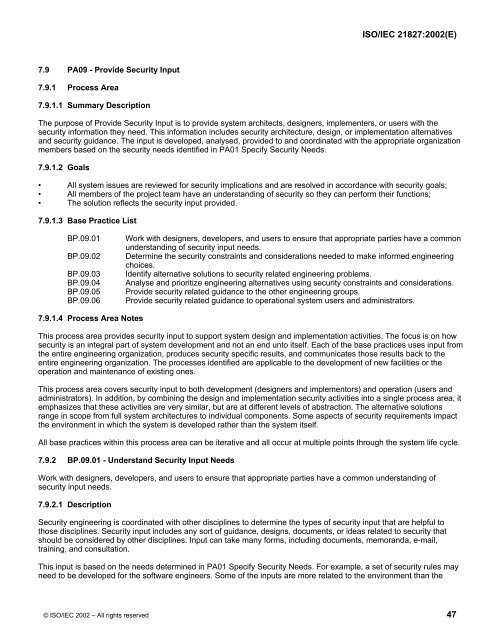ISO/IEC 21827
ISO/IEC 21827
ISO/IEC 21827
You also want an ePaper? Increase the reach of your titles
YUMPU automatically turns print PDFs into web optimized ePapers that Google loves.
<strong>ISO</strong>/<strong>IEC</strong> <strong>21827</strong>:2002(E)<br />
7.9 PA09 - Provide Security Input<br />
7.9.1 Process Area<br />
7.9.1.1 Summary Description<br />
The purpose of Provide Security Input is to provide system architects, designers, implementers, or users with the<br />
security information they need. This information includes security architecture, design, or implementation alternatives<br />
and security guidance. The input is developed, analysed, provided to and coordinated with the appropriate organization<br />
members based on the security needs identified in PA01 Specify Security Needs.<br />
7.9.1.2 Goals<br />
• All system issues are reviewed for security implications and are resolved in accordance with security goals;<br />
• All members of the project team have an understanding of security so they can perform their functions;<br />
• The solution reflects the security input provided.<br />
7.9.1.3 Base Practice List<br />
BP.09.01<br />
BP.09.02<br />
BP.09.03<br />
BP.09.04<br />
BP.09.05<br />
BP.09.06<br />
Work with designers, developers, and users to ensure that appropriate parties have a common<br />
understanding of security input needs.<br />
Determine the security constraints and considerations needed to make informed engineering<br />
choices.<br />
Identify alternative solutions to security related engineering problems.<br />
Analyse and prioritize engineering alternatives using security constraints and considerations.<br />
Provide security related guidance to the other engineering groups.<br />
Provide security related guidance to operational system users and administrators.<br />
7.9.1.4 Process Area Notes<br />
This process area provides security input to support system design and implementation activities. The focus is on how<br />
security is an integral part of system development and not an end unto itself. Each of the base practices uses input from<br />
the entire engineering organization, produces security specific results, and communicates those results back to the<br />
entire engineering organization. The processes identified are applicable to the development of new facilities or the<br />
operation and maintenance of existing ones.<br />
This process area covers security input to both development (designers and implementors) and operation (users and<br />
administrators). In addition, by combining the design and implementation security activities into a single process area, it<br />
emphasizes that these activities are very similar, but are at different levels of abstraction. The alternative solutions<br />
range in scope from full system architectures to individual components. Some aspects of security requirements impact<br />
the environment in which the system is developed rather than the system itself.<br />
All base practices within this process area can be iterative and all occur at multiple points through the system life cycle.<br />
7.9.2 BP.09.01 - Understand Security Input Needs<br />
Work with designers, developers, and users to ensure that appropriate parties have a common understanding of<br />
security input needs.<br />
7.9.2.1 Description<br />
Security engineering is coordinated with other disciplines to determine the types of security input that are helpful to<br />
those disciplines. Security input includes any sort of guidance, designs, documents, or ideas related to security that<br />
should be considered by other disciplines. Input can take many forms, including documents, memoranda, e-mail,<br />
training, and consultation.<br />
This input is based on the needs determined in PA01 Specify Security Needs. For example, a set of security rules may<br />
need to be developed for the software engineers. Some of the inputs are more related to the environment than the<br />
© <strong>ISO</strong>/<strong>IEC</strong> 2002 – All rights reserved 47
















